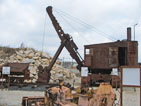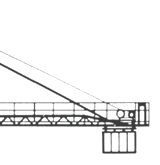Museum of cranes and construction equipment
From an unusual idea to the real thing
With a bit of pride Europe – as many other regions of our planet as well – may claim a large cultural heritage. A part of this cultural values is the industrialisation and along with that groundbreaking technical developments in various different subjects, as architecture and engineering. Included herewith is the subject of construction equipment albeit there was barely any “lobby” for this neglected subject before the 1990s.
This is in large contrast compared to the rail transport theme for example: Usually, there is a preserved speciman of nearly every old steam locomotive (if restaurated or just saved from the scrapyard), and furthermore various scale models are popular amongst model railway enthusiast.
But could have those railway lines with all their accompanying, interesting architecture existed without the construction trade and their machinery ? Would the manufacture of heavy engines and wagons be possible without customised factory halls and workshops, being created by construction workers and their tools ?
Clearly not !
Intention
Exactly this subject in all its complexity is the aim of our museum. While there was specialist literature available already before 1994, these documents were only sketchy and available for engineering students at most. There were no exhibitions about this technical demanding subject, that would have qualified as worthwhile destinations for excursions and guided tours.
This problem came into view of the founder and main initiator behind the crane and construction equipment manufacturer, Dirk Moeller, back in 1992 when he prepared lectures for apprentice construction workforce. Due to his position within a company of the construction machinery industry he got into contact with various technical universities and colleges. Here he met with Dr Ing. W. Poppy a professor who encouraged him to take steps towards a permanent exhibit after long discussions about the current situation. So Moeller decided to follow up the thought of a “museum of crane and construction equipment” as a venue for a permanent exhibit.
Obviously it is very difficult for a single person to put such a project to reality, unless there is substantial funding and enough space available.
How it began ... or: The first steps have been done!
It was the autumn of 1994 when the first vintage equipment has been donated by a construction entepreneur of Bad Hersfeld who gave up his business for retirement. This was the foundation of the museum. The two first showpieces were an old bottom slewing tower crane with topless luffing jib, and an old hydraulic excavator. The entepreneur was fascinated by the idea of the museum and he donated both machines towards it. Hence the foundation has been laid and there was no return !
Not longer “standalone“
Several months later, in 1995 due to hint by the Wolff tower crane manufacturer, two enthusiasts came into contact who are connected by a fruitful friendship ince then. After the first contact with Dietmar Thiels both were speeding up with the project, being united with the vision of making the museum possible.
Due to this collaboration more could be aimed for, and from 1996 on constantly more vintage equipment materialised !
Considerable support came also from Pius Meyer, a swiss enthusiast who joined the team in 1997. Meyer worked in the construction industry, being responsible for the equipment technology. Later he changed to a senior position within a large construction equipment manufacturer. He proved to be a valueable source of ideas and competent advice for the project.
It is all about location ...
Solely the essential question remined – a suitable, permanent and expandable location !
By initiative of the professor mentioned above, the founders of the museum came into contact with the Rüdersdorf museum park, whose organisers were searching for interesting new extensions of their subjects. Quickly it became clear that the museum of construction equipment should get a place within the park, as it was already then a unique collection. Hence, since 1998 the setup of the museum started in the museum park.
As a parallel development, the construction entepreneur Gerhard Seibold of Rattelsdorf started a construction machinery exhibit in 2006 as an extension to his leisure park dubbed “Monsterpark”, that features “Monster” excavators, loaders and trucks.
Due to significant changes in the direction of the Rüdersdorf museum park, in 2009 it was decided to move the collection from there to Rattelsdorf for a long term collaboration and a merger of both exhibits at Rattelsdorf. This is a sufficient combination of museal effort for the subject of construction equipment located at a much more central part in Germany and Europe. Furthermore the founder of the “Monsterpark” joined in as an additional, considerable initiator within the associated museum society.
The neighbourhood to “Monsterbagger“ leisure park is an ideal location for construction equipment and the historical exhibition of cranes. An extension of the initial theme of the leisure park by documentation of the technical progress on construction sites worldwide is more than appropriate. As this park is very popular, a constant flux of many visitors is guaranteed for the museum as well.
Due to the collaboration of the associated museum society “AG Kran- und Baumaschinenmuseum e.V.“ and the “Monsterpark“, the number and variety of exhibits being considerable to document technical progress is worldwide without parallels. Shortly there will be 160 different machines on display in the musuem.
This in its variety unparalleled collection of partly groundbreaking equipment in a museum is worldwide unique !






